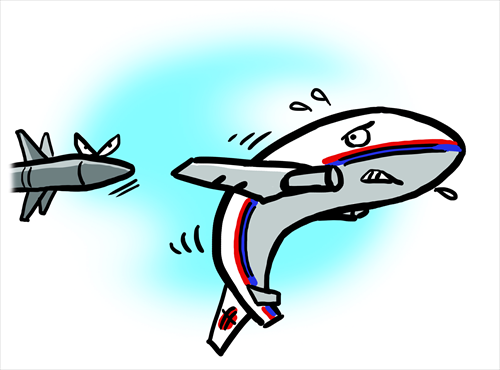MH17 disaster shows war’s new reach

Illustration: Liu Rui/GT
Although the precise details of who launched the missile that destroyed MH17 remain hotly disputed, it is clear that commercial airlines must now consider the danger facing them in a world where even irregular forces might be equipped with advanced anti-aircraft systems.
This is especially true in regions where airspace is contested or being used by one side or the other for offensive air operations.
More importantly, conflicts where one or both parties have access to long-ranged systems, as opposed to short-ranged man-portable air-defense systems (MANPADS), may make it impossible to continue to route aircraft over the affected region.
Long-ranged anti-aircraft systems pose a number of serious challenges to the safety of commercial aircraft.
First of course is their range. Traditional MANPADS are comparatively short-ranged, posing little threat to aircraft other than during the comparatively short landing and takeoff phase of their flight.
While the usage of MANPADS by terrorists remains a serious threat, it is relatively easy to avoid coming into the range of MANPADS being used in a regular military conflict.
However, long-ranged missile systems such as American Patriot system or the Russian BUKs are capable of easily striking at commercial aircraft even when they are flying at their cruising altitude.
For example, the Patriot's ceiling is approximately 24,000 meters, far above the operating altitude for most commercial jets.
In addition, most crews operating such systems are totally reliant upon their radar systems. Unlike the MANPADS or other short-ranged weapons, they cannot depend on the ability to visually verify the identity of the aircraft before deciding whether or not to fire.
This proved tragic in 1988 where the inability to visually observe Iran Air Flight 655 contributed to the US navy guided missile cruiser USS Vincennes' decision to fire on the aircraft.
The destruction of MH17 was probably a similar accident, as no credible hypothesis has been presented to explain why any group would wish to fire on a civilian aircraft.
Just as in the Vincennes case, the fact that there had been military aircraft operating in the area before the incident could have contributed to mistaken identity.
Additionally, the existence of long-range guided weapons, many of them specifically designed to home in on the radars that are used to guide ground-to-air missiles presents a serious threat to air-defense units.
While most modern missile systems include provisions to read the target's identification friend or foe (IFF) systems, the threat of attack or an untrained crew can result in these systems being ignored or misread.
Furthermore, especially in civil conflicts such as that occurring in eastern Ukraine, the veracity of any IFF system may be doubtful as both sides are using the same equipment.
Airlines must adopt a policy of avoiding any regions where the airspace may be contested, be it by aircraft or ground based air defense systems. And nations and groups involved in these conflicts should clearly identify those risk zones.
While this can be very difficult given the lack of trust that exists in these sorts of conflict, neither side would benefit from actions that result in the loss of neutral aircraft and the consequent loss of life.
But the hysterical demands that airliners should be equipped with countermeasure systems should be ignored. In addition to being complex and potentially dangerous to civilian passengers and crew, a countermeasure system might actually bring on the very attack it is intended to prevent.
After all, once used, such systems would almost certainly convince many outside observers that the target was in fact a military aircraft rather than a misidentified civilian aircraft.
The author is a freelance writer based in Corona, California. charlesgray109@gmail.com